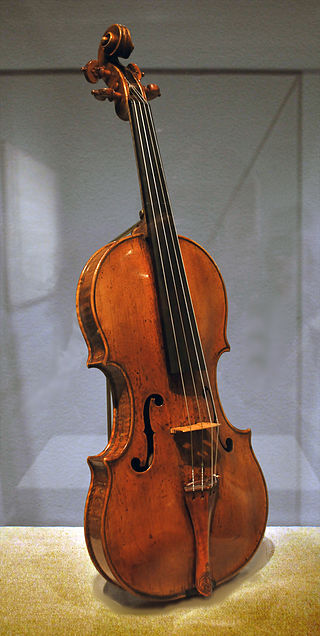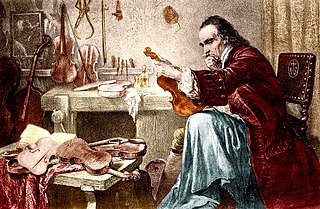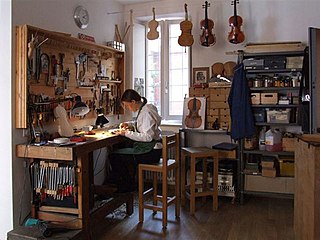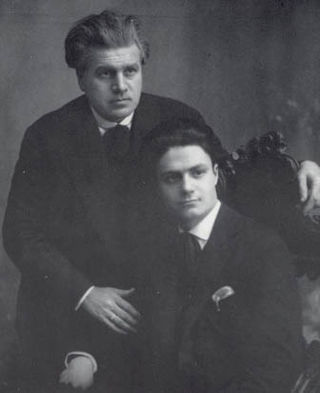Related Research Articles

Amati is the last name of a family of Italian violin makers who lived at Cremona from about 1538 to 1740. Their importance is considered equal to those of the Bergonzi, Guarneri, and Stradivari families. Today, violins created by Nicolò Amati are valued at around $600,000. Because of their age and rarity, Amati instruments are mostly kept in museum or private collections and are seldom played in public.

Antonio Stradivari was an Italian luthier and a craftsman of string instruments such as violins, cellos, guitars, violas and harps. The Latinized form of his surname, Stradivarius, as well as the colloquial Strad are terms often used to refer to his instruments. It is estimated that Stradivari produced 1,116 instruments, of which 960 were violins. Around 650 instruments survive, including 450 to 512 violins. His instruments are considered some of the finest ever made, and are extremely valuable collector's items.

A luthier is a craftsperson who builds or repairs string instruments that have a neck and a sound box. The word luthier is originally French and comes from the French word for "lute". The term was originally used for makers of lutes, but it came to be used in French for makers of most bowed and plucked stringed instruments such as members of the violin family and guitars. Luthiers, however, do not make harps or pianos; these require different skills and construction methods because their strings are secured to a frame.

Giovanni Battista Guadagnini was an Italian luthier, regarded as one of the finest craftsmen of string instruments in history. He is widely considered the third greatest maker after Antonio Stradivari and Giuseppe Guarneri "del Gesù". The Guadagnini family was known for their violins, guitars and mandolins.
Jacob Stainer was the earliest and best known Austrian and Germanic luthier. His violins were sought after by famous 17th- and 18th-century musicians and composers including Johann Sebastian Bach, Wolfgang Amadeus Mozart and George Simon-Lohein. Arcangelo Corelli was one of many who played a Stainer violin.

Carlo Bergonzi was an Italian luthier and is the first and most prominent member of the Bergonzi family, a distinguished group of luthiers from Cremona, Italy, a city with a rich tradition of stringed instrument makers. Today his instruments are highly valued for their workmanship and tone. Although he was historically assumed to have first apprenticed with Hieronymus Amati or Antonio Stradivari, he is now known to have been the student of Vincenzo Rugeri.

Sergio Peresson (1913–1991) was an Italian-born violin maker.

Gasparo da Salò is the name given to Gasparo Bertolotti, one of the earliest violin makers and an expert double bass player. Around 80 of his instruments are known to have survived to the present day: violins, alto and tenor violas, viols, violones and double basses, violas designed with only a pair of corners, and ceteras.
John Dalley is an American violinist. He was raised in a musical family. His father was an orchestra conductor, violinist, composer, instrumental teacher, and music educator. His mother, from Bloomington, Illinois, was a cellist, music teacher, and music publisher.
Giovanni Battista Rogeri was an Italian luthier, who for much of his mature life worked in Brescia. Together with Gasparo da Salò and Giovanni Paolo Maggini, Rogeri was one of the major makers of the Brescian school.

Gaetano Sgarabotto (1878–1959) and his son, Pietro Sgarabotto (1903–1990) were Italian luthier. The father made more than 700 violins, violas and cellos. The son was also a master violin maker. Both passed their experience in the craft to the next generations.
Andrea Guarneri was an Italian luthier, musician and founder of the Casa Guarneri. He is the most important student of Nicola Amati and grandfather of one of the best luthiers, Bartolomeo Giuseppe Guarneri, del Gesù.
Dimitri Musafia is an artisan maker of violin and viola cases for his own company, Musafia. Residing in Cremona, Italy, he first trained as a violinist, and subsequently as a violin maker at the Stradivari Institute in Cremona, before self-teaching to make cases, beginning in 1983, on the basis of his previous studies.
Loeiz Honoré is a violin maker living in Cremona, Italy since 1978. Despite his being self-taught, in 1988 he won the "Homage to Stradivari" Violin Making Competition organized by the City of Cremona to celebrate the 250th anniversary of the death of Antonio Stradivari.
Arthur Edward Smith, known as A. E. Smith, was an English-born Australian violin and viola maker whose violins and violas are prized for their 'excellence of tone' and 'decorative elements'. According to some musicians, "it is his violas that have the greatest reputation, being easily counted amongst the greatest ever created, regardless of era or nationality."
Pietro Giovanni Guarneri (1655–1720), also known as Pietro da Mantua or Peter Guarnerius of Mantua was a violin maker of the Guarneri family who also worked as a professional musician. Today his instruments are highly regarded, though quite rare. They are played by musicians such as Joseph Szigeti.

Traditional violin craftsmanship in Cremona was declared an intangible cultural heritage by UNESCO in 2012, during the 7th session of the Intergovernmental Committee in Paris. The Cremona's traditional violin making is an ancient form of handicraft typical of Cremona, where bowed string instruments like violins, violas, cellos and double basses have been made since the 16th century.

The Violin Museum, formerly the Stradivarius Museum, is a musical instrument museum located in Cremona. The museum is best known for its collection of stringed instruments that includes violins, violas, cellos, and double basses crafted by renowned luthiers, including Antonio Stradivari and Giuseppe Guarneri del Gesù.
Vincenzo Rugeri, was an Italian luthier of string instruments such as violins, cellos, and, violas in Cremona, Italy. His instruments are noted for their craftsmanship and tone quality. Vincenzo came from a distinguished family of luthiers, the first of whom was his father, Francesco Rugeri. Despite the local tradition of artisan families laboring together through generations, Vincenzo left the family shop and set up a successful shop of his own in the center of Cremona. Vincenzo was the third son of luthier Francesco Rugeri. Vincenzo's work, like Francesco's, is influenced by Nicolò Amati's Grand Pattern model, however Vincenzo's work was distinguished from his father's by utilizing a lower arch inspired by Antonio Stradivari. An analysis of the body of his work reveals that the quality of Vincenzo's instruments is remarkable, perhaps even more so than his father's. Vincenzo's instruments, though less numerous, are valued at least equal to those of his father. A violin by Vincenzo Rugeri realized $502,320 on October 3, 2011 at Brompton's Auctions in London. Carlo Bergonzi was a distinguished apprentice of Vincenzo Rugeri.
References
- ↑ Grannum, Hugh (30 January 1987). "Maker of music begins with wood". Detroit Free Press.
- ↑ Thompson, Polly (24 August 1997). "Music Maker: The sounds produced by virtuosos start at a Fremont workshop". Grand Rapids Press.
- ↑ "William Moennig & Son, Ltd". Maestronet.
- ↑ Walters, Patrick (7 February 2010). "Closing of the famed Moennig & Son violin shop in Philadelphia signals the end of an era". News-Sentinel. Associated Press.[ dead link ]
- ↑ Nicolini, Gualtiero (1978). The International School of Cremona: Two Score Years of Violin-Making. Cremona, Italy: Tipo Lito Persegani. pp. 93, 104. ASIN B0006E5ZWS – via Google Books.
- ↑ "Interview with Violin Maker Tim Jansma". Todd Mundt Show. NPR. 21 November 2001.
- ↑ "2012 Board and Administration". Blue Lake Fine Arts Camp.